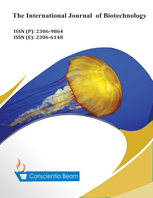Nutrient Compositions of Different Grains for Use in the Formulation of Bacteriological Media
DOI:
https://doi.org/10.18488/journal.57.2017.61.1.10Abstract
Some grains were analysed for their nutrient compositions for use in the formulation of bacteriological media in consideration of cheap and effective alternative to the conventional media. The media were respectively formulated using Acha (Digitaria exilis), Maize (Zea mays), Rice (Oryza sativa), Guinea corn (Sorghum species) and Millet (Pennisetum glaucum). Proximate analyses of the grains showed reasonable amounts of carbohydrates (55.0 to 73.9%), moisture contents (9.92 to 11.25%) and crude proteins (7.39 to 11.77%). Crude fibre and ash had the least % in the five grains used. Amongst the macro-elements, carbon is the most abundant followed by nitrogen. Using atomic absorption spectrophotometer (AAS), Zn, Co, Cu and Mo were not detectable in the grains, whereas Mn was present in minute quantities (≤ 0.015%). All the bacteria assessed grew on the formulated media. Statistical analysis of the data indicated homogeneity in growth rates of the test bacteria on most of the media formulated. However higher microbial counts observed on millet extract agar (MIEA) suggests that the medium could serve as an alternative growth medium for bacteria in place of the conventional nutrient agar (NA) with reduced cost.

